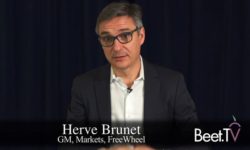MIAMI – The next generation of television—as represented by things like the ATSC3.0 standard—is now in sight. Then again, so is the moon.
To hear panelists at the recent Beet Retreat Miami explain it, lunar landings might be easier to achieve than getting TV broadcasters en masse to quickly embrace the future.
Asked by moderator Ashley J. Swartz to explain the implications of ATSC3.0, Rob Weisbord, who was recently named Chief Revenue Officer of Sinclair Digital Group, stepped up to the dais from the audience and said, “It’s taking IP technology, layering it over the linear transmitter so it gives you a hybrid approach. It puts broadcasters into a bit business.”
While that sounds exciting, reality quickly set in. Mike Kubin, EVP, Media at Invidi, explained how his company began working in 2003 with distributors to get its software into digital set-top boxes.
“It took us forever to make that happen,” Kubin said. “Right now we are in five terrific distributors in the United States. Our goals are to go international, but there’s only so much we can do. At the end of the day, they tell us what we can do or what we can’t do.”
SintecMedia CEO Lorne Brown cited a “future of TV survey” his company did in conjunction with the National Association of Broadcasters in which just 30% of respondents said they were ready for advanced TV. “Of those 30 percent, 60 percent said they were going to rely on legacy, in-house, home-grown technology to deliver advanced TV,” said Brown. “So only 30 percent are ready and 60 percent believe they can pull it off with the stuff that they have in house. I think that’s a major problem.”
Said Swartz: “All I’m hearing is more increased complexity.”
Jennifer Koester, Director of Global Partnerships for Google, took a positive approach. “I think the dichotomy that we keep talking about between linear and digital, it’s going away. I think we need to kind of step back from that and talk about solutions and technology that bridges the gap.”
She listed among the industry’s needs simplifying the ecosystem, making cross-screen reach and frequency easier, plus driving more value and being able to show it with regard to premium video inventory. That led to this exchange:
Koester: “The shift is going to happen and when it does, I think it’s going to happen very quickly.”
Brown: “I don’t think so. I think it’s going to be a slow, painful…”
Koester: “I think we’re in the slow painful part right now.”
Brown: “I think even ATSC3.0…”
Koester: “That’s going to be slow.”
Brown: “And so how fast can Comcast roll out addressable boxes? All of this is really, really slow.”
Tony Yi, GM, Strategic Commercial/Business Development for Videology, explained the complexity involved in trying to “be nimble” when dealing with integrations with systems for order entry, decisioning, trafficking, billing and CRM systems. While noting that media companies leverage Videology’s software to optimize the planning of data against media, it’s not always used for programmatic transactions.
“As an example, we just landed the press about Fox, a great partner client of ours, they use it for direct sales. They’re not using it in a programmatic fashion,” said Yi.
Swartz related a recent visit to a broadcaster to discuss a solution from her Furious Corp., only to experience a “not made here mentality.” She concluded that the meeting was a waste of time.
Brown summed up the differences between programmers and operators. “If I’m a national programmer, my strategy has to come from legacy linear outward. Versus if I’m an operator I can lean much more into advanced TV and impressions because I control the pipes and I have the data. Legacy linear for a national programmer is foundational and that’s really, really hard.”
This video was produced at the Beet Retreat Miami, 2017 presented by Videology along with Alphonso and 605. For more videos from the event, please visit this page.



























